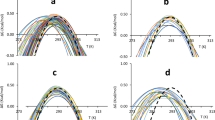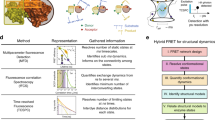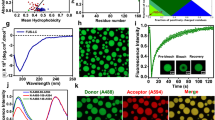Abstract
Many biochemical processes proceed through the formation of functionally significant intermediates1,2. Although the identification and characterization of such species can provide vital clues about the mechanisms of the reactions involved, it is challenging to obtain information of this type in cases where the intermediates are transient or present only at low population1,2,3,4. One important example of such a situation involves the folding behaviour of small proteins that represents a model for the acquisition of functional structure in biology1. Here we use relaxation dispersion nuclear magnetic resonance (NMR) spectroscopy to identify, for two mutational variants of one such protein, the SH3 domain from Fyn tyrosine kinase5, a low-population folding intermediate in equilibrium with its unfolded and fully folded states. By performing the NMR experiments at different temperatures, this approach has enabled characterization of the kinetics and energetics of the folding process as well as providing structures of the intermediates. A general strategy emerges for an experimental determination of the energy landscape of a protein by applying this methodology to a series of mutants whose intermediates have differing degrees of native-like structure.
This is a preview of subscription content, access via your institution
Access options
Subscribe to this journal
Receive 51 print issues and online access
$199.00 per year
only $3.90 per issue
Buy this article
- Purchase on Springer Link
- Instant access to full article PDF
Prices may be subject to local taxes which are calculated during checkout



Similar content being viewed by others
References
Fersht, A. Structure and Mechanism in Protein Science (W.H. Freeman and Company, New York, 1999)
Kahn, F., Chuang, J. I., Gianni, S. & Fersht, A. R. The kinetic pathway of folding of barnase. J. Mol. Biol. 333, 169–186 (2003)
Sanchez, I. E. & Keifhaber, T. Hammond behavior versus ground state effects in protein folding: Evidence for narrow free energy barriers and residual structure in unfolded states. J. Mol. Biol. 327, 867–884 (2003)
Klein-Seetharaman, J. et al. Long-range interactions within a nonnative protein. Science 295, 1719–1722 (2002)
Pawson, T. & Gish, G. D. SH2 and SH3 domains: from structure to function. Cell 71, 359–362 (1992)
Jackson, S. E. How do small, single domain proteins fold? Fold. Design 3, R81–R91 (1998)
Dobson, C. M. Protein folding and misfolding. Nature 426, 884–890 (2003)
Daggett, V. & Fersht, A. R. The present view of the mechanism of protein folding. Nature Rev. Mol. Cell Biol. 4, 497–502 (2003)
Northey, J. G. B., Di Nardo, A. A. & Davidson, A. R. Hydrophobic core packing in the SH3 domain folding transition state. Nature Struct. Biol. 9, 126–130 (2002)
Plaxco, K. W. et al. The folding kinetics and thermodynamics of the Fyn-SH3 domain. Biochemistry 37, 2529–2537 (1998)
Martinez, J. C. & Serrano, L. The folding transition state between SH3 domains is conformationally restricted and evolutionarily conserved. Nature Struct. Biol. 6, 1010–1016 (1999)
Grantcharova, V. P., Riddle, D. S. & Baker, D. Long-range order in the src SH3 folding transition state. Proc. Natl Acad. Sci. USA 97, 7084–7089 (2000)
Di Nardo, A. A., Korzhnev, D. M., Stogios, P. J., Zarrine-Afsar, A., Kay, L. E. & Davidson, A. R. Dramatic acceleration of protein folding by stabilization of a non-native backbone conformation. Proc. Natl Acad. Sci. USA 101, 7954–7959 (2004)
Palmer, A. G., Kroenke, C. D. & Loria, J. P. NMR methods for quantifying microsecond-to-millisecond motions in biological macromolecules. Methods Enzymol. 339, 204–238 (2001)
Mulder, F. A. A., Mittermaier, A., Hon, B., Dahlquist, F. W. & Kay, L. E. Studying excited states of protein by NMR spectroscopy. Nature Struct. Biol. 8, 932–935 (2001)
Dunitz, J. D. Win some, lose some. Enthalpy–entropy compensation in weak intermolecular interactions. Chem. Biol. 2, 709–712 (1995)
Oliveberg, M., Tan, Y. J. & Fersht, A. R. Negative activation enthalpies on the kinetics of protein folding. Proc. Natl Acad. Sci. USA 92, 8926–8929 (1995)
Dobson, C. M., Sali, A. & Karplus, M. Protein folding: A perspective from theory and experiment. Angew. Chem. Int. Edn Engl. 37, 867–893 (1998)
Vendruscolo, M., Paci, E., Dobson, C. M. & Karplus, M. Three key residues from a critical contact network in a protein folding transition state. Nature 409, 641–645 (2001)
Xu, X. P. & Case, D. A. Probing multiple effects on 15N, 13Cα, 13Cβ, 13C′ chemical shifts in peptides using density functional theory. Biopolymers 65, 408–423 (2002)
Northey, J. G. B., Maxwell, K. L. & Davidson, A. R. Probing folding kinetics beyond the Phi value: Using multiple amino acid substitutions to investigate the structure of the SH3 domain folding transition state. J. Mol. Biol. 320, 389–402 (2002)
Maxwell, K. L. & Davidson, A. R. Mutagenesis of a buried polar interaction in an SH3 domain: sequence conservation provides the best prediction of stability effects. Biochemistry 37, 16172–16182 (1998)
Bax, A. Multidimensional nuclear magnetic resonance methods for protein studies. Curr. Opin. Struct. Biol. 4, 738–744 (1994)
Wishart, D. S. & Sykes, B. D. The 13C chemical-shift index: a simple method for the identification of protein secondary structure using 13C chemical-shift data. J. Biomol. NMR 4, 171–180 (1994)
Tollinger, M., Skrynnikov, N. R., Mulder, F. A. A., Forman-Kay, J. D. & Kay, L. E. Slow dynamics in folded and unfolded states of an SH3 domain. J. Am. Chem. Soc. 123, 11341–11352 (2001)
Paci, E., Vendruscolo, M., Dobson, C. M. & Karplus, M. Determination of a transition state at atomic resolution from protein engineering data. J. Mol. Biol. 324, 151–163 (2002)
Noble, M. E., Musacchio, A., Saraste, M., Courtneidge, S. A. & Wierenga, R. K. Crystal structure of the SH3 domain in human Fyn; comparison of the three-dimensional structures of SH3 domains in tyrosine kinases and spectrin. EMBO J. 12, 2617–2624 (1993)
Press, W. H., Flannery, B. P., Teukolsky, S. A. & Vetterling, W. T. Numerical Recipes in C (Cambridge Univ. Press, 1988)
Acknowledgements
This work was supported through grants from the Canadian Institutes of Health Research (A.R.D, L.E.K and D.M.K.), the European Comission (X.S.), the Royal Society (M.V.), the Leverhulme Trust (M.V. and C.M.D.) and the Wellcome Trust (C.M.D.). L.E.K. holds a Canada Research Chair in Biochemistry.
Author information
Authors and Affiliations
Corresponding authors
Ethics declarations
Competing interests
The authors declare that they have no competing financial interests.
Supplementary information
Supplementary Information
Includes information on fitting of dispersion profiles and structure calculations; Table 1S. Folding kinetics parameters obtained from a global fit of CPMG dispersion data for Fyn SH3 mutants; Table 2S. X2 target functions obtained in global fits of CPMG dispersion data for 23(26) residues of G48M(G48V) measured at 5(4) temperatures and 3(2) magnetic fields using 2- and 3-site exchange models; Table 3S. Thermodynamic parameters for G48M(G48V) mutants of the Fyn SH3 domain obtained from a global fit of CPMG dispersion data using 3- and 2-site exchange models. Table 4S. Backbone 15N chemical shift differences between states F and I (δFI) and between states F and U (δFU) and their ratio Δexp=δFI/δFU for G48M and G48V mutants of the Fyn SH3 domain; Figure 1S. Average r.m.s deviation from the native state as a function of residue number for the calculated I states of G48M and G48V; Figure 2S. Relaxation dispersion curves recorded for G48M at concentrations of 1.0 and 0.3 mM, 15 and 30oC, do not depend on protein concentration. (PDF 282 kb)
Rights and permissions
About this article
Cite this article
Korzhnev, D., Salvatella, X., Vendruscolo, M. et al. Low-populated folding intermediates of Fyn SH3 characterized by relaxation dispersion NMR. Nature 430, 586–590 (2004). https://doi.org/10.1038/nature02655
Received:
Accepted:
Issue Date:
DOI: https://doi.org/10.1038/nature02655
This article is cited by
-
Beyond slow two-state protein conformational exchange using CEST: applications to three-state protein interconversion on the millisecond timescale
Journal of Biomolecular NMR (2024)
-
Studying micro to millisecond protein dynamics using simple amide 15N CEST experiments supplemented with major-state R2 and visible peak-position constraints
Journal of Biomolecular NMR (2023)
-
Retrospective study for the universal applicability of the residue-based linear free energy relationship in the two-state exchange of protein molecules
Scientific Reports (2022)
-
Mutate-and-chemical-shift-fingerprint (MCSF) to characterize excited states in RNA using NMR spectroscopy
Nature Protocols (2021)
-
NMR and computational methods for molecular resolution of allosteric pathways in enzyme complexes
Biophysical Reviews (2020)
Comments
By submitting a comment you agree to abide by our Terms and Community Guidelines. If you find something abusive or that does not comply with our terms or guidelines please flag it as inappropriate.



